Win CENS ProFlex DX5 earplugs worth £1,149 – enter here
What it means to be a professional stalker
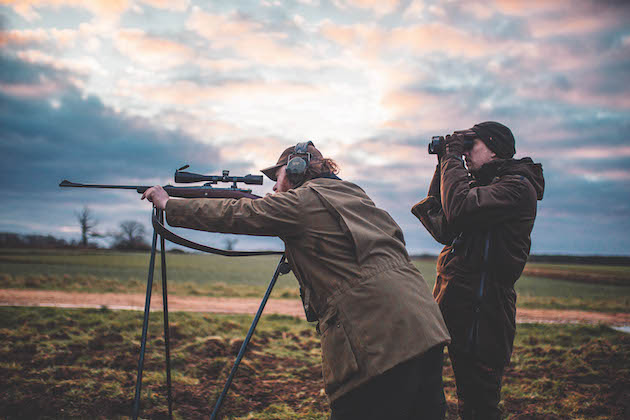 Sam Carlisle takes aim
Sam Carlisle takes aim
I am stalking on the edge of the Breckland at Euston and following estate stalker Chris Rogers in pursuit of roe and muntjac. The two roe we are watching are almost hidden by the scrub. With their heads down it also hides us from them and we quietly close the distance to 100 yards.
The rifle rests on the sticks and we’re ready to take our chance when a clear shot presents itself. Chris points out the older of the two. I follow it in the cross-hairs. The younger deer gives us an opportunity but the older one always seems to pause with brash obscuring its shoulder.
“Take your head off the stock. Rest a bit,” Chris advises. A career of watching guests get overanxious waiting for the shot means he knows the signs. You can become fatigued staring down a scope, tension building while you wait to fire.
There is no rush, the scrub is dense. Wait for the sun to rise a little further and the deer will make their way out of this area and into the open.
Chris has been the professional deerstalker at Euston for 16 years, managing the four species that roam these 10,500 acres of Suffolk. He originally trained as a gamekeeper, but on a placement year during his time at college, he worked in deer management in Herefordshire. “It was something to add to my CV,” he says. “I’d done plenty of work on shoots and rearing fields, so this seemed like a good addition. In the end, I found working with deer considerably more interesting.”
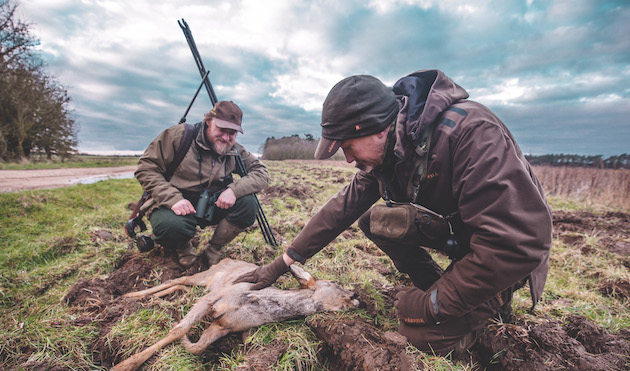
Sam Carlisle and Euston Estate stalker Chris Rogers grass a good beast
Time vanishing
A gentle nod in the direction of the deer tells me that they are moving out of the scrub. The older deer steps tentatively on to the track and stares in our direction, confused by the new shapes on its horizon. When a deer looks at you, there is a sense of time vanishing. I rest the cross-hairs just behind her shoulder and squeeze the trigger. The .243 barks, she stumbles forward, sways and collapses.
The morning is still early and we decide to move from the open fields into a large block of ancient woodland in search of a muntjac. As we walk past more old oak trees, Chris points out that they form an old avenue, heading to the wood. “Being the stalker at Euston feels like being part of a long tradition of managing deer. Deer have been an essential part of this landscape for 1,000 years,” he says. “The big wood was mentioned in Domesday and during the medieval era it was a royal hunting ground. Five hundred years later, a park of about 2,000 acres was enclosed for deer hunting, with the wood preserved increasingly for commercial timber.
“While priorities have changed, deer remain a central part of this landscape’s identity. I’m just one person in a long list of those charged with their stewardship.”
Looking at these fields, once parkland exclusively for hunting and now vital for growing root crops and supporting the estate, the deer management of today has a different ethos to all those years ago. “During my career the industry has changed hugely,” muses Chris. “When I began, there weren’t many professional deer management jobs in England, only some contract culling. There are even fewer now.
“Deerstalking has become tremendously popular and farmers realise that enthusiasts will pay them a decent rent for permission. A couple of decades ago, it was farmers paying someone to control the deer. The picture has completely changed and for anyone looking to get into professional deer management it is an increasingly crowded sphere. Scotland still employs a lot of stalkers and in some ways I wish I’d spent a season or two up there in the hills.
“But if I had it to do over, I’d look towards Canada or the US. Not only are they huge, with very varied hunting, but the industry is just a different scale. There are more jobs and more opportunities.”
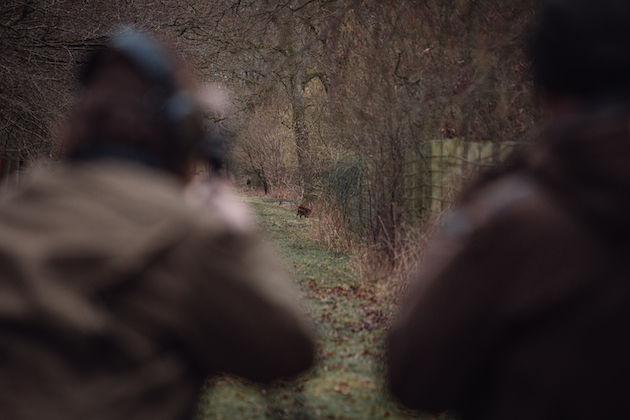
Taking aim on a muntjac buck
Professional deerstalker
Reaching the wood, Chris lowers his voice. Slowly we round the corner to gaze down a wide ride, hoping to see a muntjac grazing along an edge. Instead, we see a small herd of red deer, unfazed by our presence as they congregate at the far end. We stand and watch them for a while, hoping they’ll move off gently without spooking the surrounding area.
“Another thing about North America,” Chris picks up where he left off, “is that they seem to value their big game more. Keeping a herd of red deer or fallow on your land means that you have to tolerate the woodland or agricultural damage. Understandably, most farmers around here aren’t able to do that. Yet if you ask a member of the public what the most iconic bit of wildlife in the Brecks is, I’m sure a large number would say ‘red deer’.
“The situation is worse politically as well. It seems the answer to all our environmental problems is to simply kill more deer. There is no nuance or recognition of the role they’ve played, environmentally and culturally, in a landscape like this for centuries.”
With an ambitious tree-planting regime proposed by the Government, there’s no doubt that the habitat available for deer will boom over the coming years. It will be vital to have a sensible policy in place for managing deer in these new woodlands, but the modern deer manager is sitting at an impossible political crossroads. On one hand they grapple with educating the public that control is necessary in the first place; that killing deer is critical for the wider ecosystem to thrive.
On the other they must convince policymakers that deer have a central place as part of our fauna; that living landscapes can thrive alongside them. Chris, the local representative for the National Gamekeepers’ Organisation, is more active in this advocacy than most, but he recognises it is a Herculean task.
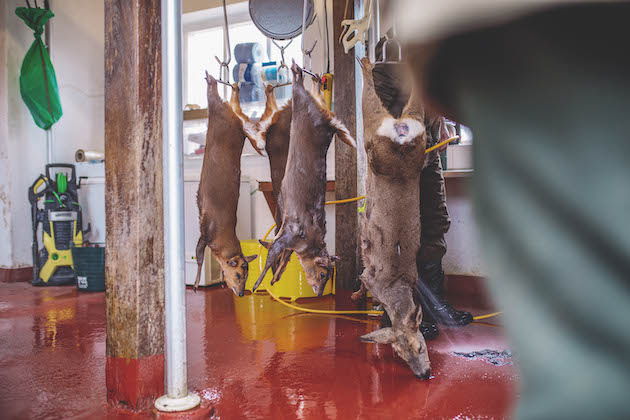
Deer management is a vital part of Euston Estate, which has a dedicated larder for the carcasses
The red deer lazily trot off. We creep silently down the ride, peering cautiously round corners. We spot a few muntjac but mostly as they’re bouncing away from us. Woodland stalking for muntjac, which constantly move as they browse, is like close combat — you need to be both quick and decisive.
As we veer off the ride into a thicket of hazel coppice, our pace slows further. Pausing under the canopy of a large oak, Chris spots a young buck and doe, with just enough space to thread a shot cleanly through the trees. As we set the sticks, one of them is quartering away slightly with its head turned to look over its back. I squeeze the trigger.
The deer spins round and teeters before sinking to the ground. Having seen thousands of deer react to shots, Chris is less than convinced this one is fatal. Anyone who has stalked enough deer can relate to the sinking feeling of a shot gone awry. Chris does his best to reassure me, keeping me calm in case a follow-up shot is required. We settle in for the obligatory 10-minute wait. Scanning the area carefully, Chris spots the deer, its head and neck just visible, clearly wounded but sadly still alive.
I move carefully into position, hoping to take any shot that might present itself. Just as I focus on its neck, it becomes aware of us, staggers up and moves off, further into cover. I feel sick. This is the worst of all possible outcomes. Armed with a thermal imager, we make excruciatingly slow progress towards the shot site, scanning the brambles on either side for any heat signature.
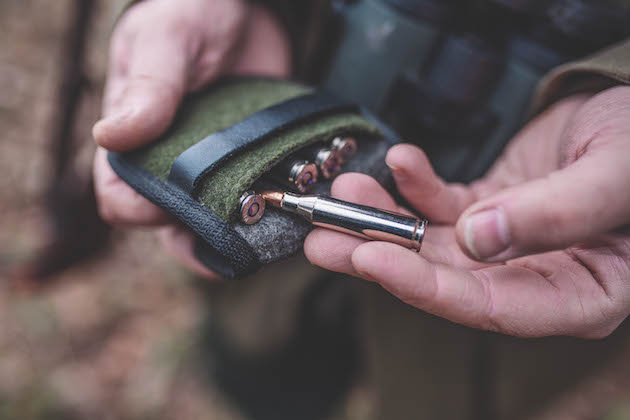
There are four species of deer at Euston, so ammunition has to be carefully selected
Tension
As we wait, Chris motions for me to pass him the rifle. He slowly lifts it, aims at the ground about 15 yards away, into the brambles, and fires. The tension is gone as he cycles the bolt. “Sorry, it was so close and knew we were here, so there was no time to describe where it was.”
I am hugely relieved we found the deer and despatched it, minimising any suffering. On inspection, my shot only grazed its front shoulder, not even breaking the skin, but the hydrostatic shot of the bullet seemed to have broken bones as well.
The flawed shot is a reminder of how different the job of a professional is to that of a part-time enthusiast. They must navigate the competing political narratives of the day and are expected to have input into those discussions. They are on the frontline of ensuring that our precious landscape and critical biodiversity are maintained, with ungulates and orchids existing side by side.
Dedicated professional deerstalkers like Chris have to do all this while prioritising the welfare of the deer alongside a growing client list that has embraced this popular sport. If you would like to stalk on the Euston Estate please contact Chris at eustondeerhunting@yahoo.co.uk
Related Articles
Get the latest news delivered direct to your door
Subscribe to Shooting Times & Country
Discover the ultimate companion for field sports enthusiasts with Shooting Times & Country Magazine, the UK’s leading weekly publication that has been at the forefront of shooting culture since 1882. Subscribers gain access to expert tips, comprehensive gear reviews, seasonal advice and a vibrant community of like-minded shooters.
Save on shop price when you subscribe with weekly issues featuring in-depth articles on gundog training, exclusive member offers and access to the digital back issue library. A Shooting Times & Country subscription is more than a magazine, don’t just read about the countryside; immerse yourself in its most authoritative and engaging publication.







